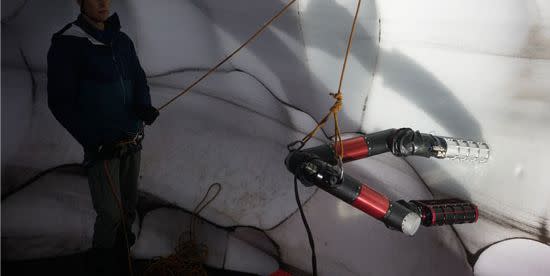NASA's Robotic Worm Could Someday Climb Alien Ice Spikes

There are some places on Earth that humans simply can't go. Mount Erebus in Antarctica is a good example. The second tallest volcano in the continent offers a potential treasure trove of ancient DNA in its walls, but they're off limits to humans. Our lungs simply couldn't handle the high levels of carbon dioxide within its tunnels. Mount Erebus and places like it are why NASA is building an ice-climbing robot called IceWorm.
Developed within the Extreme Environments Robotics Group at NASA's Jet Propulsion Lab (JPL), the IceWorm has been in the works since 2016. Aaron Curtis, IceWorm's lead designer and a postdoc at JPL, had studied Mount Erebus for his doctoral work and wished he could have survived the deadly tunnels.
“It seemed really clear to me that we needed robots that could go in there. So I started looking around to see if anyone had made a robot who could get around on ice,” Curtis tells Eos, the magazine of the American Geophyiscal Union. While JPL has developed rock-climbing robots called LEMURs in the past, Curtis couldn't find a robot specifically up to the challenge of climbing through ice.
The IceWorm gets its name from the way it moves through the world. Around four and a half feet tall (1.4 meters), the bot centers itself in the ice with two feet using steel alpinist screws made for climbing, one foot higher than the other. The robot unscrews its lower foot, then collapses its body until the two feet are near each other. This free foot then screws itself back in while the higher foot moves out, stretching the robot's body up the icy wall.
Curtis says the robot “inchworms up the wall" and that the IceWorm incorporates "a whole new way to move around” for a robot.

These aren't just regular steel screws, though. They contain pressure sensors that can tell the IceWorm how hard to drill into each particular section of ice, maintaining a delicate balance of rotation and forward thrust. Each drilled step will also function as a sample, storing materials in its legs.
The IceWorm's had a successful test run in a potentially explosive setting-Washington state's Mount St Helens, home of a tremendous volcanic eruption in 1980. Reporting in an abstract to the AGU, Curtis said that "climbing was unsuccessful in firn [granular snow two-thirds as dense as water] but successful in glacial ice." Speaking to Eons, Curtis called the 8 hour climb the IceWorm's first "successful test."
"We’re mostly just focusing on the mobility at the moment,” Curtis explained. “It’s at the extremely early stages of this technology.”
The potential for IceWorm is vast. If IceWorm could climb through a wide variety of icy environments while taking samples, it could prove an invaluable tool of study both on Earth and in space exploration. On the home planet it could navigate areas like Mount Erebus, on faraway mission it could climb through the frozen landscapes of worlds like Enceladus or Europa, where icy spikes upwards of 50 feet tall intimidate orbital landers.
While using an inchworm as inspiration might be novel for a robot's travels, animal inspiration for robotic movement is widespread. Even tiny animals, like inchworms or fruit flies, can give engineers the ideas for leaps forward in robotic technology. Perhaps someday the most advanced robots will catch up with ants.
Source: Eos
('You Might Also Like',)

